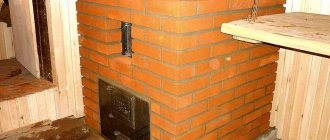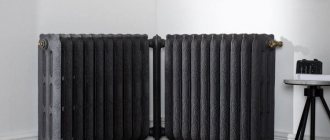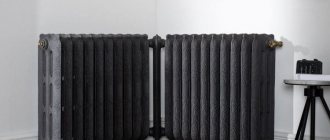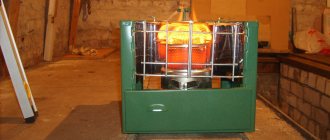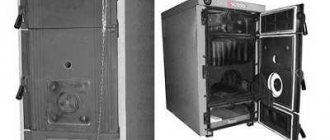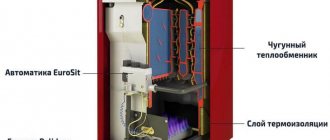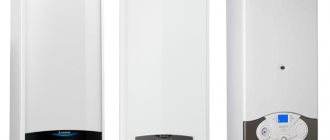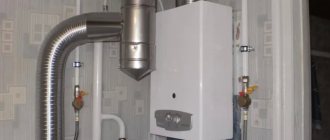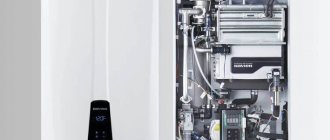Russia is one of the countries with a very harsh climate. In most of its territory, winters are very cold. Having heating in homes is vital. Practice shows that one of the best options for organizing heating of a building is the use of gas as fuel, and the most popular are floor-standing gas units.
We will talk about what floor-standing gas heating boilers are. From the article we present, you will learn how the equipment operates and what it needs for stable, trouble-free operation. In order to facilitate the selection of the optimal model, we analyze the main criteria and characteristics of the best options.
Open type floor standing boiler
The combustion chamber of such a boiler is open. During operation, it uses the air of the room in which it is installed.
- This single-circuit floor-standing boiler does not require an electrical connection.
- The power is regulated mechanically, the burner is equipped with a piezo lighter.
- Capable of heating large areas. The disadvantage is the high requirements for the premises.
When installing a boiler with an open combustion chamber, a chimney is required, because natural traction is used.
Burner flame
One of the indicators of proper burner operation is the color of the flame. Gas equipment is characterized by an even bluish flame without admixtures of other colors. The presence of yellow or red splashes indicates that the burner is not working well, which reduces the efficiency of the heating equipment.
First of all, this applies to injection burner devices, but sometimes it is also typical for fan burners. The flame may simply lack oxygen. Also, dust and other small debris can get in with the air, which will clog the device, reducing the efficiency of the boiler. All this directly affects the flame. If it hums, the burner is loud, or the fire has changed color, you need to adjust the correct operation of the device.
Closed floor standing boiler
Boilers with automated combustion process.
- The combustion chamber in them is closed and air exhaust systems are provided.
- Automation is computerized.
- It is possible to program the heating temperature and operating time.
- Modern models use remote control units.
- For the smooth operation of such a unit, electricity is required.
Which gas boiler is better to choose?
This section is intended to tie all previous discussions to real life, because theory and practice are different things. Theoretically, everything is correct; the most economical gas boiler with the highest efficiency is a condensing boiler. But having learned how much this miracle of technology costs, not everyone will dare to buy it. And is there such a need?
Take the same gravity system, which does not require pumps, automation and electricity. It is not advisable to buy an expensive heat source for it, although a turbocharged or condensing heat generator will cope well with such a system. It will simply force the coolant to circulate forcibly from its own pump. The question is the reliability of power supply and the decent price of equipment, which will pay off when it is unknown.
It is also not very reasonable to buy a condensing boiler for a small house of 100 square meters. m of area with any heating system. In such an area, you are unlikely to feel the efficiency compared to an inexpensive aspirated engine. You can see a real difference if a country cottage with an area of over 300 square meters. First, heat it with a simple boiler, and then change it to a condensing boiler.
Floor-standing boiler heat exchanger
When choosing a heating boiler, the question arises not only of appearance and functionality. Many people also think about the heat exchanger material.
Cast iron or steel? As a rule, Russian manufacturers have a cast iron heat exchanger, while foreign ones have a steel one.
Each of these materials has its own advantages and disadvantages.
- Cast iron has a long service life and practically does not rust. However, it is a rather fragile material, on the surface of which microcracks may form. Water hardness can have a bad effect on the condition of a cast iron heat exchanger. Cast iron units are also bulky and heavy.
- Steel is more ductile than cast iron, less sensitive to mechanical and thermal shocks, but is more susceptible to corrosion. It is important to strictly observe the operating conditions of the steel heat exchanger in order to increase its service life.
Main disadvantages
However, a gas heating boiler also has certain disadvantages. The main ones are the following:
- installation of floor-standing boilers is more complicated, in contrast to the wall-mounted counterpart;
- the need for installation in a special room;
- energy dependence;
- high cost of equipment for automatic boiler control;
- The kit does not include strapping elements.
In addition, despite the high safety of gas installations, their operation still needs to be monitored, since even minor interruptions disrupt the normal production cycle.
Rating of floor-standing boilers TOP-5 best models
When choosing a floor-standing boiler, many factors are taken into account. The main ones are the power and area of the heated room.
The best floor-standing boilers running on natural gas are collected in the TOP 5 single-circuit boilers.
Lemax "Premium" -12.5
Single-circuit boiler of the Premium series with a power of 12.5 kW with an open combustion chamber.
- Heated area – up to 120 sq.m. The heat exchanger is steel, 2 mm thick.
- The anti-corrosion coating protects the heat exchanger from external influences.
- Efficiency: 90%. Non-volatile. Quite easy to maintain and manage. Average price: RUB 22,070.
Baxi SLIM 1.230 iN
The Italian manufacturer presents a single-circuit convection boiler.
- The thermal power of this boiler is 22.1 kW. Open combustion chamber.
- The maximum area of the heated room is up to 200 sq.m.
- Cast iron heat exchanger, steel burner.
- Equipped with an electronic automation system, auto-ignition and overheating protection.
- The advantages of this boiler include the ability to connect underfloor heating and hot water supply.
- Efficiency 90.2%. Average price: RUB 55,653.
Pechkin KSG-12.5
Floor-standing gas boiler of Russian production with a power of 12.5 kW with mechanical control.
- Non-volatile. Heated area – up to 120 sq.m. Steel heat exchanger.
- Reliable design with minimal settings.
- Temperature regulation is carried out by a thermostat on the front panel.
- Based on reviews of floor-standing boilers, we can say with confidence that this is the best option at an affordable price of good quality.
- Efficiency: 87%. Average price: RUB 19,835.
Protherm Wolf 16 KSO
An excellent boiler with a power of 16 kW, for rooms up to 160 sq.m., compact in size.
- Most often, such a boiler is used for heating small country houses.
- Mechanical control, piezo horn.
- Equipped with draft and flame sensors, indicators of temperature and pressure of a steel heat exchanger.
- Economical gas fuel consumption is an advantage of this unit.
- Efficiency: 92.5%. Average price: RUB 25,738.
De Dietrich DTG X 23 N
A cast iron boiler from a French manufacturer with an atmospheric burner meets all necessary standards and is designed taking into account Russian operating conditions.
- Maximum power 23 kW. Can heat rooms up to 250 sq.m.
- The heat exchanger is made of high quality cast iron.
- Reinforced thermal insulation of the entire boiler was used.
- It is possible to connect a boiler.
- Electromechanical control panel with thermostat, wide range of settings and protections.
- Efficiency: 90.3%. Average price: RUB 87,070.
The price of floor-standing boilers depends on the manufacturer, power output, heated area and heat exchanger material, as well as on the automation system and the presence of various sensors and indicators.
Selection of gas equipment
When choosing, the main task is much broader than simply determining which gas boiler is the most economical and reliable. It is necessary that the equipment meets the conditions of a private home and is suitable for the heating system. Solving this problem requires understanding what types of heat generators there are today and how they differ from each other. There are currently three types of gas-using equipment on the market:
- pressurized condensing boilers;
- supercharged (turbocharged) with a closed firebox;
- atmospheric with open firebox.
The above types are manufactured in wall and floor versions. Only in atmospheric boiler models can you choose wall-mounted (parapet) products with a side chimney outlet that goes horizontally to the street through the wall. There are double-circuit varieties of boilers that are used as a boiler to provide hot water.
The design in a wall-mounted or floor-mounted version does not affect the power and practicality of the boiler. The only thing that matters is the operating principle and design of the heat generator.
Atmospheric units
This gas equipment is not one of the most economical devices, since the efficiency does not often exceed 83%, and the temperature of the burned gas at the exit into the pipe is about 160 °C. The reason is the usual version of fuel combustion with a free supply of oxygen from the boiler room. When there is an excessive amount of air in the air-fuel mixture, not the most favorable conditions for fuel combustion begin to be created, which negatively affects the efficiency of the heater. An increased temperature of combustion products indicates ineffective heat exchange and loss of thermal energy.
There is one more important point. Many burners that are installed in cheap atmospheric boilers can only operate in one mode. In other words, to maintain the temperature of the coolant, the burner is regularly turned on and off. This is the simplest operating principle, but not the most economical. But one way or another, this equipment is very popular for several reasons:
- reliability and simplicity of the device;
- lack of electrical components;
- independence from the availability of electricity;
- low cost.
Not all atmospheric equipment is energy independent. There are a large number of models from different manufacturers that are equipped with automation and control equipment that consume electricity. However, their presence does not increase the efficiency of boiler equipment.
To heat a house with an open firebox that works naturally, it is best to install an atmospheric boiler that does not require electricity. Even despite the relatively low power of this equipment. These units are designed to heat buildings in areas with unstable electricity supply. In this case, we are not talking about savings if during a power outage the boiler stops working and the rooms in the house begin to cool.
Pressurized thermal generators
The closed combustion chamber and forced air circulation, which are implemented in these devices, improve the combustion conditions of liquefied and natural gas. In turbocharged boilers, unlike atmospheric ones, the following types of burners are used:
- modulation;
- two- and multi-stage.
The idea is that when the specified coolant temperature is reached, these burners switch to a lower level of fuel combustion activity (first type) or smoothly reduce the intensity of the combustion process to a minimum (second type). That is, the automated boiler control system itself controls the burner power, taking into account the thermal load or the signal from the DHW operation. It is for this reason that the efficiency of turbocharged boilers is 91-95%.
According to reviews, turbocharged wall-mounted gas boilers are in first place for individual heating of apartments. However, not at all because of the increased efficiency, but due to the coaxial chimney, which is horizontally discharged to the street through the wall. This allows you not to equip a chimney pipe, and also not to connect the heating device to the ventilation shaft, which is strictly prohibited by SNiP.
Condensing devices
By and large, these are the same forced-air heat generators with a closed firebox, but with increased efficiency - up to 97%. This is achieved thanks to the closed design of the heat exchanger, which surrounds the cylindrical burner around the entire perimeter. Thus, it is possible to recover the thermal energy of vaporization lost during combustion. The resulting water begins to evaporate at elevated temperatures during combustion, then the steam, after contact with the heat exchanger, condenses and transfers back thermal energy.
Condensing gas equipment is the most economical equipment for heating a private home. Provided that electricity is supplied to the area without interruption or there is an alternative power source - a diesel or gasoline generator . Like turbocharged heating boilers, condensing equipment cannot operate without electricity.
Since these devices are more technologically advanced, their cost is quite high. This can be attributed to the only significant drawback; according to other characteristics, only electrical installations with an efficiency of 98% are more economical.
Connecting a floor-standing boiler
Installing a heating system and connecting a gas boiler yourself is very difficult. In most cases, such work is entrusted to professionals.
There are many companies that have the appropriate qualifications.
The work is carried out in several stages:
- Preparation of documents. First of all, they contact the gas service to find out the possibility of installing gas equipment in the house. There they receive technical conditions, according to which the project is ordered. The project prescribes diagrams for laying a gas main in the room and connecting equipment.
- Preparing the installation site. Floor-standing boilers are installed on a special base, in a ventilated room, at a certain distance from the walls and ceiling. If necessary, install a chimney.
- Installation, connection and configuration of gas equipment.
- Installation and connection of pipelines and heating radiators.
- Filling the system with coolant.
- Test run of the heating system.
Recommendations from experts
Theoretically, the most practical and economical gas boilers for heating a private home with maximum efficiency are condensing boilers. However, after learning the cost of this equipment, not every homeowner will dare to purchase it. Therefore, you can buy a conventional gravity system, which does not require electricity, automation or a pump.
It is also not very cost-effective to purchase condensing equipment for a small building with an area of less than 150 square meters. m with any type of heating. In this area, the savings will not be noticeable, unlike the purchase of an inexpensive atmospheric boiler.
When choosing gas equipment, you do not need to focus only on efficiency; you must also be guided by considerations of necessity and expediency. If the house does not have a chimney pipe, it is best to choose a forced-air heat generator when there are power outages - a non-volatile atmospheric boiler. If the cottage has more than two floors, it is advisable to install a condensing unit. You can make a boiler economical in other ways, for example, by conventional insulation of the house.
Modern gas boilers are efficient equipment, inferior only to electric generators in terms of efficiency. But the level of efficiency depends on the presence of high-tech elements in their mechanism, and, accordingly, on the cost of the device as a whole. The same condensing units are as economical as they are expensive. At the same time, an ordinary inexpensive boiler can fully satisfy the needs of the homeowner.


